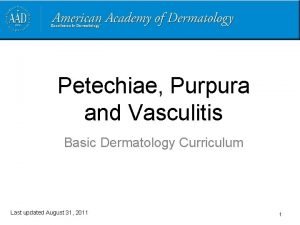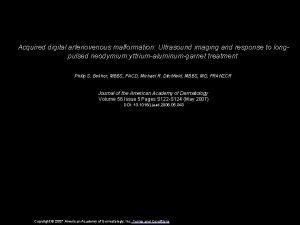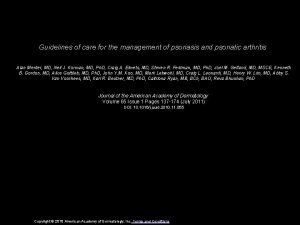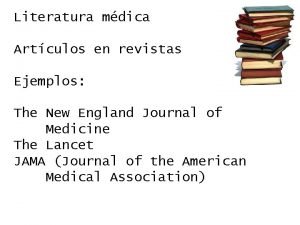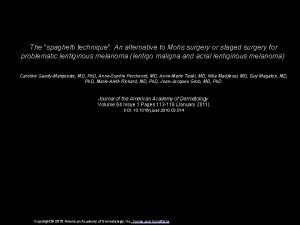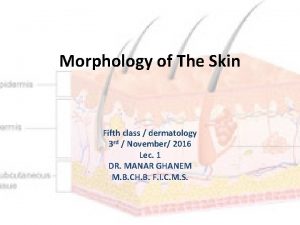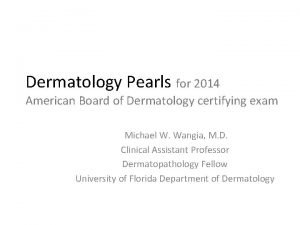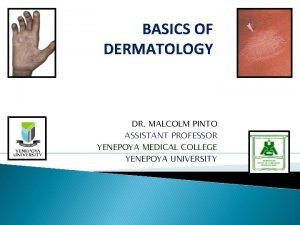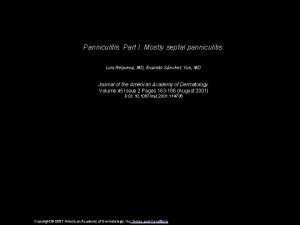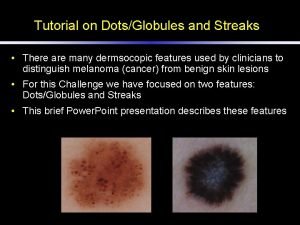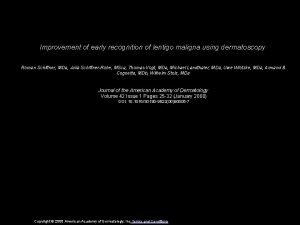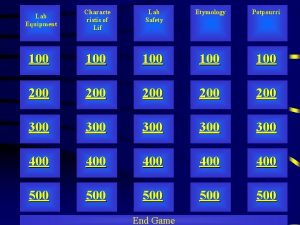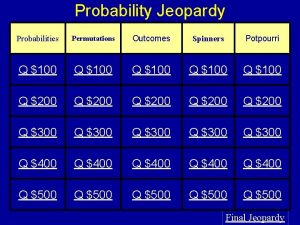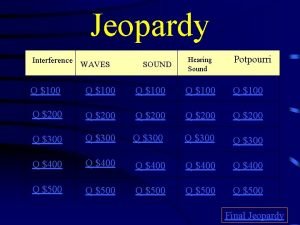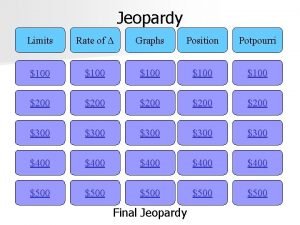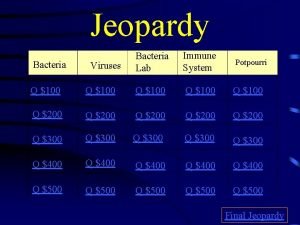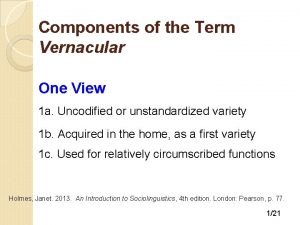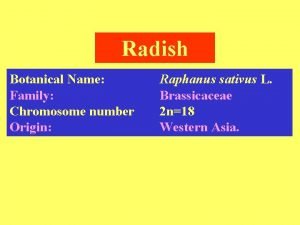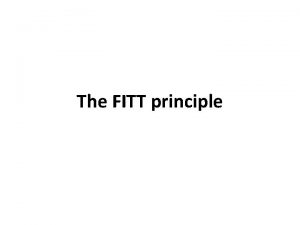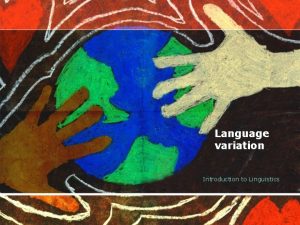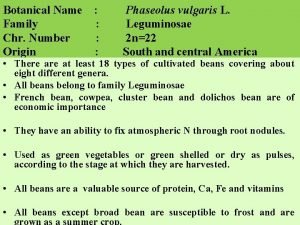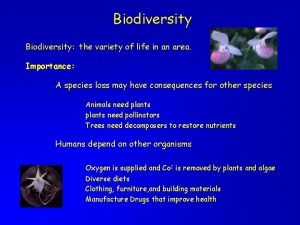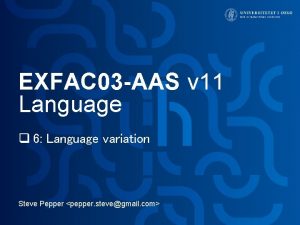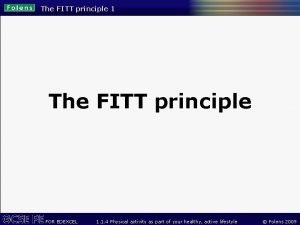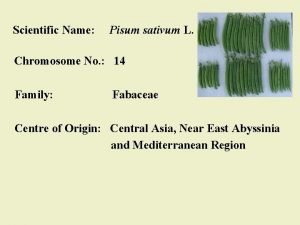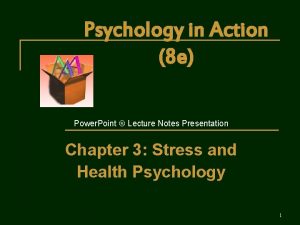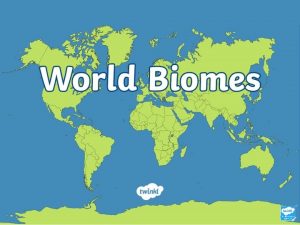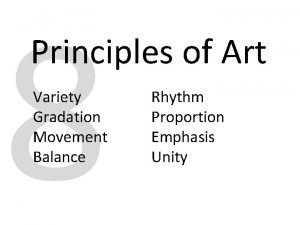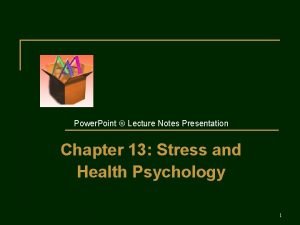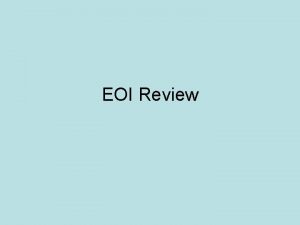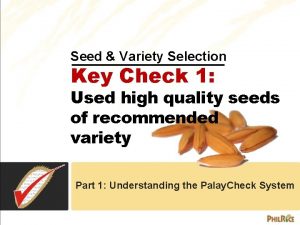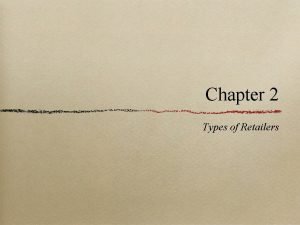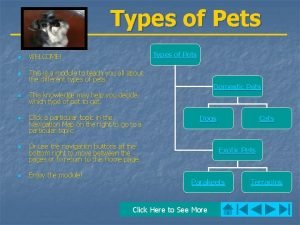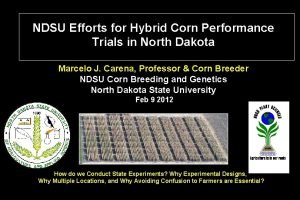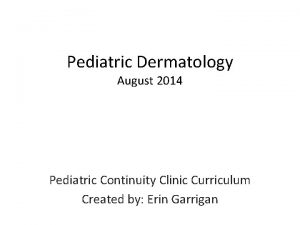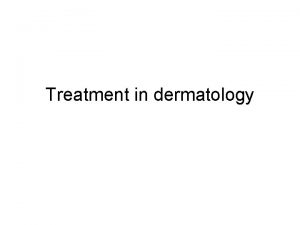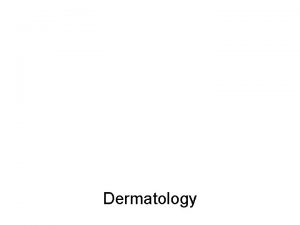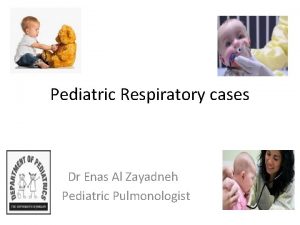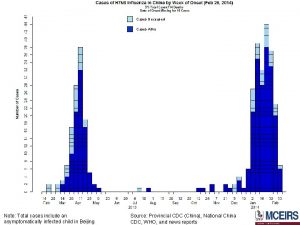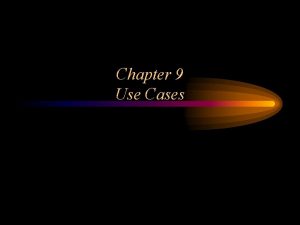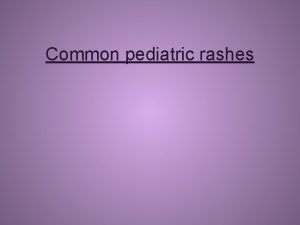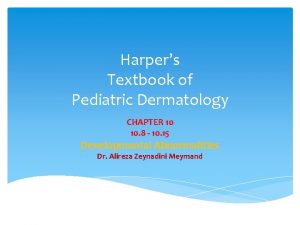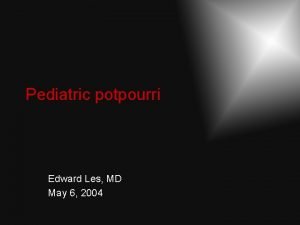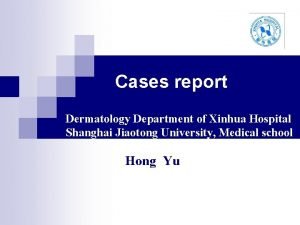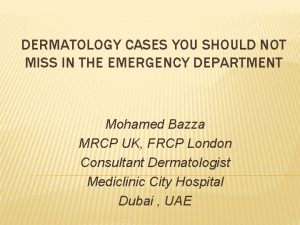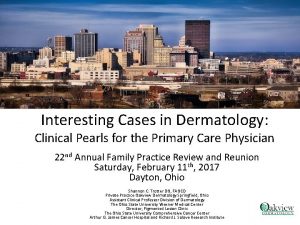Pediatric Dermatology Potpourri A Variety of Cases Teresa
















































































- Slides: 80

Pediatric Dermatology Potpourri: A Variety of Cases Teresa S. Wright, MD, FAAP Le. Bonheur Children’s Hospital Memphis, TN

Disclosures • Sanofi Genzyme- Advisory Board

Learning Objectives • Recognize features of several unusual skin conditions in children. • Describe the key features that support the correct diagnosis. • List one important lesson demonstrated by each case.

Case #1 • • • 14 mo old female Pit on the nasal bridge With hairs No hx of redness, pain, swelling, drainage Mom advised to “pluck the hairs”



Nasal Dermoid Sinus Cyst (NDSC) • Most common congenital midline nasal lesion • 1 -3% of all dermoids • 4 -12% of head/neck dermoids Kim HK et al. Clinical and Experimental Otorhinolaryngology. Vol 3(1): 48 -51, March 2010.

NDSC • • Cystic mass or sinus opening Midline nasal dorsum Between glabella and columella At birth or during early childhood

NDSC • Potential Complications – Nasal deformity – Infection • Meningitis • Intracranial abscess

NDSC • Imaging – CT and/or MRI • Complete surgical excision – Plastic surgery – Neurosurgery

Lesson • A tiny lesion can have potential for serious complications.

Case #2 • • • 21 mo old female 2 weeks of blistering rash No fever or other systemic symptoms No new medications + pruritus

Case #2 • Physical exam: – tense vesicles and large tense annular bullae (many with hemorrhagic centers) – serous and hemorrhagic crusts – superficial erosions – scattered diffusely over face, trunk, groin, buttocks, and bilateral upper and lower extremities – mucous membranes are clear



Chronic Bullous Disease of Childhood (CBDC) • Most common acquired AI blistering disorder of children • 6 mo – 10 yr (mean = 4. 5 yr) Mintz EM and Morel KD. Dermatol Clin 29(2011) 459 -462.

CBDC • Presentation – Abrupt onset – Clear/hemorrhagic tense vesicles/annular bullae • String of pearls • Cluster of jewels • Rosette

CBDC • Distribution – Face, trunk, extremities • Lower trunk, groin, medial thighs – +/- mucous membranes • Symptoms – Variable • Asymptomatic to severe pruritus • +/- burning

CBDC • DDx – Bullous impetigo • Superficial, fragile bullae – EBA – Other AI bullous

CBDC • Diagnosis – Biopsy • Subepidermal • Neutrophilic infiltrate – DIF • Linear Ig. A at BMZ

CBDC • Pathogenesis – Not well understood • Component of BMZ becomes antigenic – Often idiopathic – Genetic susceptibility • haplotypes HLA-B 8, Cw 7, DR 3 – Triggers • Infections, drugs, vaccinations, UV radiation, malignancy

CBDC • Course – Remits spontaneously – Several mos to 4 years • By puberty – Non-scarring • dyspigmentation

CBDC • Treatment – Dapsone* – Topical steroids – Systemic steroids – Other IS agents • MMF, Cs. A – Antibiotics • Anti-inflammatory Mintz EM and Morel KD. Dermatol Clin 29(2011) 699 -700.

Lesson • Can be difficult to control • Multiple agents may be needed • Will generally remit

Case #3 • • 37 week male Triplet gestation Fetal demise at 17 weeks Remaining sister healthy




Aplasia Cutis Congenita (ACC) • • Congenital absence of skin Localized or widespread Superficial or deep Typically presents with eroded, absent, or scarred areas of skin at birth

ACC • Etiology – No single cause – Disruption of skin development has occurred • Multi factorial – Genetic factors – Teratogens – Decreased blood supply – Trauma

ACC • Scalp is most common site – 86% of solitary lesions – 80% at parietal hair whorl – Size ranges from small to large • Large may extend to dura or meninges • ? Graft for >3 -4 cm 2 – Shape varies • Round, oval, linear, stellate Frieden, IJ. J of Am Acad Derm. Volume 14(4): 646 -656.

ACC (9 Groups) 1. 2. 3. 4. 5. 6. 7. 8. 9. Scalp ACC without multiple anomalies Scalp ACC with assoc limb abnormalities Scalp ACC with assoc epidermal and organoid nevi ACC overlying embryologic malformations ACC with assoc fetus papyraceus or placental infarcts ACC assoc with EB ACC localized to the extremities, without blistering ACC caused by specific teratogens ACC assoc with syndromes

ACC (Group 5) • Etiology – Ischemic and/or thrombotic events in the placenta and fetus – Sporadic • Management – Conservative • Gentle cleansing • Vaseline gauze dressings



Lesson • Severe lesions will often heal well with minimal intervention.

Case #4 • FT healthy male • Several crusted papules on face and trunk at birth



Congenital Self Healing Reticulohistiocytosis (CSHR) • “Hashimoto-Pritzker Disease” • Rare variant of LCH • Limited to skin only

CSHR • Birth or neonatal period – Red brown papules/nodules – +/- ulceration – Single or multiple – Involute w/in weeks to months

CSHR • Incidence? – Not clear • Likely underreported – Spontaneous resolution – Lack of recognition

CSHR • True CSHR is a benign process. • However: – cannot predict systemic involvement based on skin findings – thorough evaluation and follow up are indicated Stein SL et al. Arch Pediatr Adolesc Med 2001; 155: 778 -783.

CSHR • Up to 53% of pts with multisystem LCH present with skin lesions • 35 patients referred for presumed skin limited LCH – 40% had multisystem dz • Bone (70%) • Risk organ (liver, spleen, bone marrow) (50%) Simko SJ et al. J Pediatr Nov 2014; Vol 165(5): 990 -996.

Lesson • Babies with “CSRH” should have a thorough evaluation for multisystem disease.

Case #5 • 2 yr old male • p/w “bumps on the skin” and an abnormal fingernail


Case #5 • History – “bumps” on arms present for months – Nail change present for months – Chronic dermatitis at the base of penis – Recent “abscess” in left thigh • I&D with negative cultures

Case #5 • PExam – Few small waxy dome shaped papules on arms • Molluscum contagiosum – Left index fingernail • Subungual hyperkeratosis, onycholysis – Faint pink patch at base of penis – Non tender nodule in left thigh with well healed scar

Langerhans Cell Histiocytosis! • Nail changes (rare) – Nail dystrophy – Subungual hyperkeratosis – Purpuric striae – Subungual pustules – Onycholysis – Longitudinal grooves – Paronychia – Loss of nail plate Kumar V et al. Pediatr Dermatol. 2017; 34: 732 -734.

Nail Changes in LCH • DDx: – Psoriasis, LP, AA, Darier’s, Reiter syndrome – Infection • Bacterial (esp with paronychia) • Fungal

Nail Changes in LCH • Prognostic factor? – Controversial • ? Correlation with multisystem disease – Poor prognosis • Spontaneous resolution – even a severe case Prayogo RL et al. Pediatr Dermatol. 2020; 37: 180 -183.

“Molluscum” • “LCH mimicking molluscum contagiosum: A case series” – Fernandez Armenteros et al. Pediatr Blood Cancer. 2018; 65: e 27047. • Up to 80% have skin involvement – Wide range of features – Classic: mimics seb derm • Erythematous scaly papules/plaques on scalp and diaper area – “molluscum” type is rare

Lesson • LCH can present with nail dystrophy. • LCH can mimic molluscum. • Have a high index of suspicion when patient has multiple unusual skin findings.

Case #6 • FT male • Uncomplicated pregnancy • Right leg swollen, hard, purple, tender



Kaposiform Hemangioendothelioma (KHE) • Rare vascular tumor – Extremities, trunk, retroperitoneum • Labs – Platelets low (16, 000) – Fibrinogen low – D-dimer elevated – PT/PTT WNL

Kasabach-Merritt Phenomenon (KMP) • Severe thrombocytopenic coagulopathy • Typically seen with rare vascular tumors – KHE > tufted angioma • Mechanism – Platelet trapping • Clinical – Rapidly enlarging infiltrative vascular tumor – Often painful

KHE/KMP • Management – Avoid platelet transfusion! • Unless active bleeding • Exacerbate platelet trapping – Cryoprecipitate may be given, if needed – PRBC’s for symptomatic anemia only – Pain control

KHE/KMP • Management – Primarily pharmacologic • • Systemic steroids Vincristine Alpha interferon Sirolimus Blatt J et al. Pediatr Blood Cancer 2010; 55: 1396 -1398.

KHE/KMP – Surgery (for small tumors) • Rarely possible – Other: • Radiation • Embolization Mahajan P et al. Clin Med Insights Blood Disord. 2017 Mar 16: 10.

KHE

Lesson • Avoid platelet transfusions! • Sirolimus can be very effective for KHE/KMP.

Case #7 • 2 week old FT female • p/w "red marks" on left chest, arm, and hand – Present at birth – Not visibly changing


Interim History • Delay in follow up • RSV – Anemia – Heme/onc consult – prbc’s • Le. B ED – Swelling, ? tenderness of left chest


Hospital Course • Hgb/HCT= 6. 6/21. 5 – Transfused with prbc’s • Stool guiaic +

Hospital Course • Imaging – Head ultrasound – Abdominal ultrasound • One lesion c/w “hemangioma” – Ultrasound of left chest • c/w deep infantile hemangioma – MRI of chest/arm • c/w “venous malformation” – Echocardiogram • WNL

Hospital Course • Anemia continues • GI work up – EGD and colonoscopy negative • OR: – Laparotomy with push endoscopy – Biopsy of left chest lesion


Hospital Course • Biopsies of small intestine and chest lesions – c/w infantile hemangioma • GLUT-1 positive • MRI/MRA of head/neck – negative

Treatment • Propranolol • Prednisone • Close follow up – prbc’s

Segmental Hemangioma • Increased risk – Complications – Associated abnormalities • PHACE, LUMBAR syndrome – Visceral lesions

Segmental Hemangioma – Assoc of non facial segmental HOI • Visceral lesions –Liver> GI tract> brain Metry DW et al. Arch Dermatol May 2004. Vol 140: 591 -596.

GI Bleeding as a Complication of Segmental HOI • Report of 10 patients – Female – Hispanic or Caucasian – Large segmental HOI • Facial (8) and non-facial (2) – +/- PHACE syndrome (9/10) Drolet BA et al. , J Pediatr. Vol 160(60): 1021 -1029.

Segmental HOI of GI Tract – Lower GI bleeding • Multiple rbc transfusions • Difficult to diagnose • Located in small intestine/mesentery – Segmental – Assoc with arterial anomalies » Vascular dysplasia of the aorta

Lessons • Atypical morphology of segmental hemangioma • Risk of visceral HOI – Even with non-facial segmental HOI • Localized • Segmental – Present with GI bleeding

Thank You! • twrigh 43@uthsc. edu
 Criminal cases vs civil cases
Criminal cases vs civil cases Dermatology case presentation
Dermatology case presentation Hsp vs itp
Hsp vs itp Mohs microsurgery
Mohs microsurgery Dermatology
Dermatology Coumadin clinic emory
Coumadin clinic emory Dermatology journal
Dermatology journal Principles of topical therapy in dermatology
Principles of topical therapy in dermatology Rajan dermatology
Rajan dermatology Stallman
Stallman Dermatology journal
Dermatology journal Primary and secondary lesions of skin
Primary and secondary lesions of skin Conference center valencia
Conference center valencia Etas dermatology
Etas dermatology Dermatology billing performance
Dermatology billing performance Abrasion definition
Abrasion definition Dermatology journal
Dermatology journal Dermatology journal
Dermatology journal Dermatology science fair projects
Dermatology science fair projects Korzenko dermatology
Korzenko dermatology Somc dermatologist
Somc dermatologist El salto menu
El salto menu Dermatology journal
Dermatology journal Characterization jeopardy
Characterization jeopardy Potpourri jeopardy
Potpourri jeopardy Jeopardy potpourri
Jeopardy potpourri Lab etymology
Lab etymology The wooden bowl conflict
The wooden bowl conflict Potpourri jeopardy
Potpourri jeopardy Potpourri jeopardy
Potpourri jeopardy Potpourri jeopardy
Potpourri jeopardy Potpourri category jeopardy
Potpourri category jeopardy Potpourri jeopardy
Potpourri jeopardy Prefix and suffix jeopardy
Prefix and suffix jeopardy Potpourri jeopardy
Potpourri jeopardy Potpourri jeopardy
Potpourri jeopardy Potpourri jeopardy questions
Potpourri jeopardy questions What is variety of language
What is variety of language Vernacular variety
Vernacular variety Radish plant scientific name
Radish plant scientific name What are the four components of the fitt principle
What are the four components of the fitt principle Numerous variety
Numerous variety Harmony in shapes
Harmony in shapes Language
Language French bean variety pusa parvati is evolved through
French bean variety pusa parvati is evolved through Variety of life in an area
Variety of life in an area Exfac
Exfac Economic importance of sunflower
Economic importance of sunflower Refers to the variety of training a performer undertakes
Refers to the variety of training a performer undertakes Gradiation rhythm in interior design
Gradiation rhythm in interior design Difference between field pea and garden pea
Difference between field pea and garden pea Odyssey by car
Odyssey by car Walter cannon observed that a variety of stressors trigger
Walter cannon observed that a variety of stressors trigger Variety and variability
Variety and variability Sentence variety exercises
Sentence variety exercises Variety of resources
Variety of resources Acrostic poem on weather
Acrostic poem on weather Biomes
Biomes Fitt principle for badminton
Fitt principle for badminton Ano ang halimbawa ng barayti ng wika
Ano ang halimbawa ng barayti ng wika What is standard variety of language
What is standard variety of language Gradation principle of art
Gradation principle of art Digital library perspectives
Digital library perspectives Walter cannon observed that a variety of stressors trigger
Walter cannon observed that a variety of stressors trigger What is this picture
What is this picture Cumulative sentence example
Cumulative sentence example Prepare a variety of sandwiches
Prepare a variety of sandwiches Product variety and quality under monopoly
Product variety and quality under monopoly Typology of operations
Typology of operations Convenience products examples
Convenience products examples Check variety
Check variety Variation dimension in operations management
Variation dimension in operations management Kitar nitrogen
Kitar nitrogen Type of retails
Type of retails Number and variety of pets
Number and variety of pets Add a little variety to your questions
Add a little variety to your questions Volume velocity variety veracity
Volume velocity variety veracity Vary various variety
Vary various variety Ndsu corn variety trials
Ndsu corn variety trials Adj of vary
Adj of vary Essentially derived variety
Essentially derived variety


